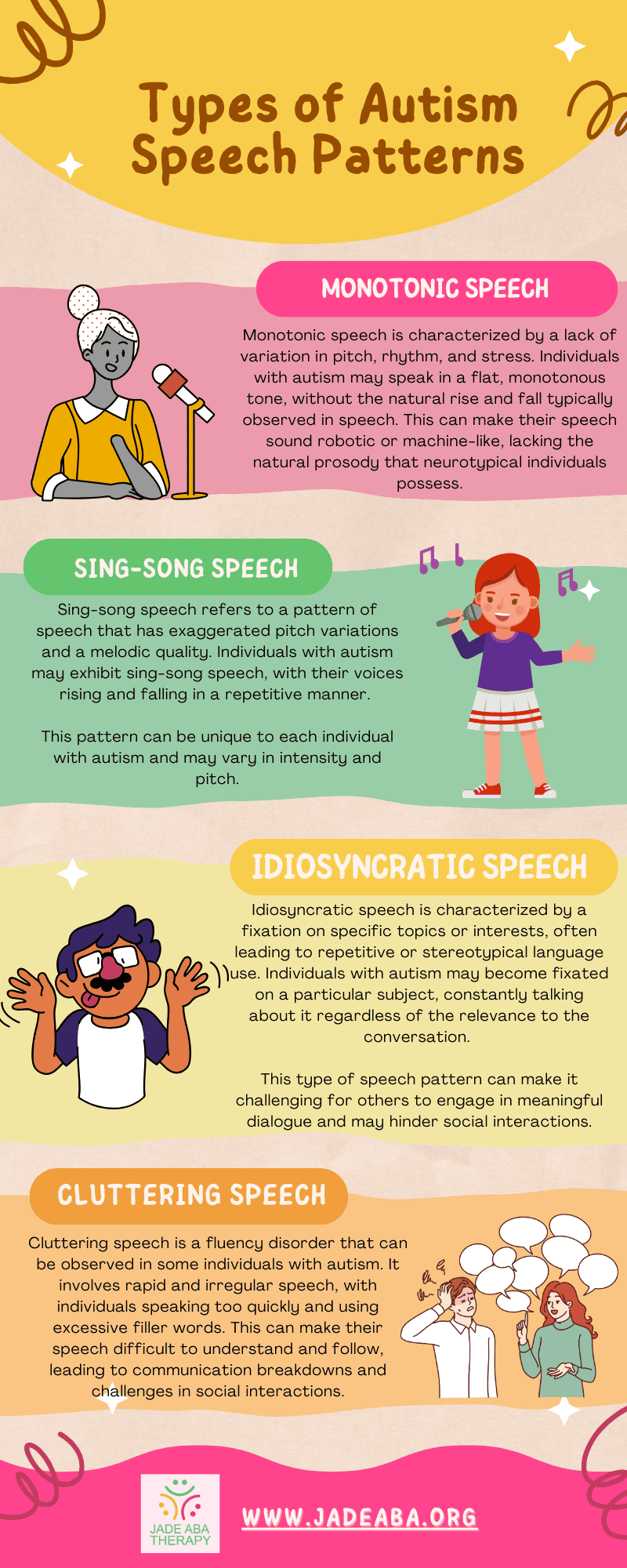Autism spectrum disorder (ASD) is characterized by a wide range of communication difficulties, including atypical speech patterns. These atypical speech patterns can have a significant impact on individuals with autism as they can affect their ability to effectively communicate and interact with others. Understanding these patterns is crucial for parents, caregivers, and individuals themselves.

Impact of Atypical Speech Patterns
Atypical speech patterns in individuals with autism can lead to misunderstandings and social communication difficulties. These patterns may include a flat tone, atypical pitch, or a lack of variation in voice inflection. This can make it challenging for individuals with autism to convey emotions, intentions, and subtle nuances in their speech.
As a result, these individuals may struggle to form and maintain relationships, both personal and professional. In fact, these speech patterns may also impact employment prospects for individuals with autism. The ability to effectively communicate is often a crucial factor in various jobs and professions. Therefore, addressing and understanding these atypical speech patterns is essential for them to thrive in social and professional settings.
Types of Autism Speech Patterns
Autism speech patterns can encompass a range of characteristics that differ from typical speech patterns. Some common types of autism speech patterns include the following:

Early Signs and Diagnoses
Understanding the early signs of autism and the diagnosis process is crucial for early intervention and support. Communication development plays a significant role in the diagnosis of autism, as speech patterns often exhibit unique characteristics in individuals on the autism spectrum. Most children with autism can be diagnosed as early as two years old, and signs of autism and speech development frequently appear within the first three years of a child’s life.
Parents and caregivers should be aware of common red flags that may indicate the presence of autism. These can include delayed or absent speech, limited social interaction, difficulty understanding nonverbal cues, and repetitive or unusual behaviors. It’s important to note that these signs can vary from person to person, and not all individuals with autism will exhibit the same characteristics.
If parents or caregivers notice any concerning signs, it is crucial to consult with a healthcare professional or developmental specialist. They will conduct a comprehensive evaluation, which may include observations, interviews, and standardized assessments, to determine if the child meets the criteria for an autism diagnosis.
Communication Development in Autism
While some children with ASD may have delayed speech development, others may never develop verbal communication skills. These children may rely on non-verbal methods to communicate their needs, such as clapping, shaking their heads, or gesturing. Others may face challenges with receptive language, experiencing difficulty understanding and processing spoken information.
It is important to recognize that not all individuals with autism will have the same communication abilities or challenges. Some may have difficulty with expressive language, struggling to form sentences or use appropriate grammar.
Early intervention and therapy can play a crucial role in supporting communication development in individuals with autism. Speech-language therapists and other professionals can provide strategies and techniques to enhance communication skills, such as using visual supports, implementing alternative communication systems, and promoting social interaction.

Challenges and Therapies
While individuals with ASD may exhibit a wide range of speech patterns, there are common challenges that many face, particularly in the area of prosody. Prosody refers to the intonation, rhythm, and stress patterns of speech, and it plays a crucial role in communication and social interactions. Understanding these challenges and exploring therapeutic approaches can help support individuals with autism in their speech development.
Difficulties with Prosody
Prosodic deficits are frequently observed in individuals with autism. Many of them can’t use prosody effectively, resulting in what is often described as a “flat” voice. This flat tone can be misinterpreted as a lack of interest, intelligence, humor, or emotion, potentially leading to misunderstandings in social interactions.
Even individuals with ASD who possess verbal skills, high IQs, and extensive vocabulary may still struggle with prosody and language use. Difficulties in interpreting tone, context, and body language can lead to unintended offense, confusion, hurt feelings, and negative interactions in conversations.
Therapeutic Approaches for Autism Speech
Currently, there are no fully developed therapies specifically designed to address challenges with prosody in individuals with autism. However, ongoing research is exploring various therapeutic approaches to support speech development in autistic individuals.
One area of research involves investigating speech processing in autism spectrum disorder. By understanding the neural mechanisms underlying prosodic deficits, researchers aim to develop targeted interventions to improve prosody production and comprehension.
Additionally, comprehension of figurative language is another area being explored. Autistic individuals may struggle with understanding idioms, metaphors, and other non-literal language, which can impact their ability to interpret and respond appropriately in social situations. Therapies focusing on figurative language comprehension aim to enhance communication skills and social interactions.
It’s important to note that therapy approaches for autism speech should be individualized based on the unique needs of each person. Speech and language therapists, along with other professionals experienced in working with individuals on the autism spectrum, can provide tailored interventions and strategies to address specific speech challenges.